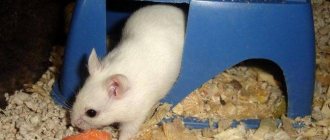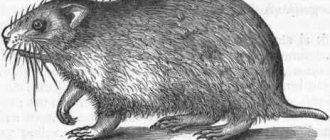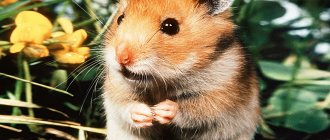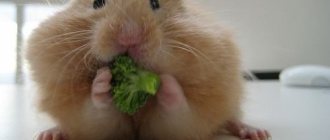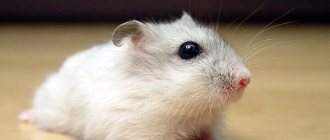How to get rid of obesity?
Fat, clumsy hamsters need to review the food they eat and the feeding system in general. Do not forget that the maximum daily dose of balanced food for crumbs is two spoons, characterized as tablespoons. Hamsters develop habits quickly, so it is recommended to feed them small portions at the same time. In order for your pet’s diet to be balanced, it is necessary:
- reduce the amount of grain consumed by the animal;
- add vegetables, fruits, berries in small quantities to the main products;
- reduce the number of nuts in the feed.
In addition, it is worth reconsidering the number of accessories intended for organizing the animal’s leisure time placed in the cage. Among them must be:
How to determine if you are overweight?
To find out if your hamster is obese, you need to do the following:
- Take the animal in your hands and gently lay it on its back.
- Feel the ribs from the abdominal side.
If during the examination you notice that the ribs protrude and can be felt too clearly, this indicates that the animal is underweight and needs to be fed better. The inability to feel the ribs indicates that the pet has problems with excess weight. If each of the animal's ribs can be felt individually, but they do not protrude, we can say with confidence that the pet's weight is normal.
Habits and behavior
Large hamsters living in nature are nocturnal. During the day they climb into holes and sleep. The rodent's home is a complex underground system of passages. It can have from one to five exits and several compartments for storing food and nesting.
When dusk comes, rodents go in search of food. They run several kilometers during the night. They feed on seeds and leaves of plants, vegetables and tubers. Sometimes their diet includes larvae and insects, as well as small invertebrates.
Guard! What to do if you are overweight?
No need to panic, take action. If you have asked a veterinarian for help, he will help you create the right diet and daily routine. Or take care of it yourself.
So: good mood, diet and exercise. First of all, solve the issue with training. In nature, rodents travel several kilometers a day, so they need exercise. Buy a quality wheel and a special ball for walking around the room
Pay attention to playing with your hamster, but do not forget to keep a close eye so as not to lose him
Now it's time to reconsider your diet. How often do you feed your hamster fatty nuts and seeds? It is not necessary to exclude them, just cross out junk food from the daily menu and use it as a rare treat.
a href=”https://letsreboot.files.wordpress.com” >letsreboot.files.wordpress.com
Add as many vegetables and fruits as possible. Carrots, cabbage, celery and apples are great. Never offer your pet oranges - sour citrus fruits harm digestion and cause stomach diseases.
Finally, make the fat guy work hard for food! There is no need to carefully put it in the feeder every day. Move it to another part of the cage so that the hamster has to run around in search of a hearty dinner. Don't worry, he will benefit from burning some calories.
How to contact?
Gaining trust will take patience and time. All the efforts expended will subsequently be more than repaid, since the pet will soon begin to show affection and boundless trust. So, what not to do:
- make rough and sudden movements with your hands close to your pet;
- pick up a sleeping or recently awakened animal;
- cover with your palms, trying to catch;
- make loud noises near the cage;
- leave the rodent on high ground;
- grab the scruff of the neck with your fingers;
- Trying to introduce a furry cat to a cat would be a fatal mistake.
It is recommended to constantly talk to the animal, give treats from your hands and treat it affectionately.
Reasons for the decline in the Malagasy giant rat population
Like many of Madagascar's unique species, the Malagasy giant rat is highly endangered due to habitat loss, environmental disturbance, predation, and competition with introduced species.
The only species of the genus Hypogeomys.
In recent years, illegal logging has been carried out in the forests of Madagascar to produce charcoal, and areas have been cleared of trees for crops or grazing. All this activity had devastating consequences, as a result of which the forest turned into dense bushes, unsuitable for the habitat of the Malagasy giant rats.
Animals feed primarily on fallen fruits.
These animals suffer from human intervention in the remaining forests, which are used by local residents to collect firewood, honey, dig root crops, and hunt tenrecs and lemurs. Predation by dogs also plays a significant role in the extinction of the Malagasy giant rat.
The biggest hamster
The large animal reaches a length of 35 cm, and the weight of the hamster can be up to 1 kg. It is this kind of animal that is considered a pest in the garden, as it surrounds the beds and collects supplies for the winter. The plumpest hamster can dig a hole up to 8 meters long. In it he puts food in special compartments.
But even such an animal cannot compare with the huge capybara, which looks like a rodent. Its height reaches 0.6 meters and length 1.4 meters. At the same time, an adult rodent weighs 34-66 kg. The animal can be found in Central and South America.
And the smallest hamster belongs to the Roborovsky breed. They are only 5-6 cm long.
Peppermint treat
Ingredients:
- 1 medium overripe banana.
- 2 chicken eggs.
- 3 tbsp. spoons of honey.
- 3 tbsp. tablespoons of liquid coconut oil (can be replaced with sunflower oil in the same amount).
- 1/2 teaspoon mint flavoring.
- 1/2 teaspoon baking powder.
- A quarter cup of carob (roasted carob powder). A small amount of cocoa can be substituted, but this is not recommended for animals. Therefore, try to find an original product.
- Oat flour.
Cooking procedure.
1. Mash the banana in a bowl.
2. Beat eggs into the resulting mass, add honey, baking powder, cinnamon and coconut (sunflower) oil.
3. Add oatmeal to the mixture to form a firm but slightly moist dough.
4. Divide the resulting volume into 2 equal parts.
5. Pour 1/4 cup of carob powder into one half, and add the same amount of flour to the second half. A hard lump should form that does not stick to your hands.
6. Roll out 2 rectangles, 9-10 mm thick.
7. Place the layers of dough on top of each other and roll along the long side. Wrap the resulting sausage in plastic wrap and put it in the refrigerator overnight.
8. Preheat the oven to 180 degrees.
9. Cover a baking sheet with parchment paper.
10. Remove the film and cut into 3-3.5 cm rounds.
11. Place on a baking sheet. During cooking, portions of dough will not increase in volume, so you can place them close to each other.
12. Bake for 10-15 minutes.
If you want to please your pet with a crunchier treat, cut the rolls into thin slices (about 1 cm), and after cooking, additionally dry them in a warm oven or even in a non-stick frying pan.
The finished product is stored for a long time in a dry place. So, by baking peppermint rolls once, you can treat your four-legged pupil with them for a long time.
Bon appetit to your dog!
I like it I don't like it
Appearance of the largest animal
You can see in the photo what the largest hamster in the world looks like. There are some features in their body structure:
Read also: What are the Linux system requirements?
- Pets' ears are short and covered with hard fur.
- The tail at the base is thick.
- The fingers have fairly developed claws.
- Wide feet.
Rodents have a uniform color, which can vary from red to brown. Black individuals are rare. There are approximately 10 subspecies of such animals.
About the content
How picky is the little inhabitant? In fact, hamsters from China are easier to keep than their counterparts. To keep a Chinese hamster you need:
A cage with sparse vertical bars. This is a prerequisite for a pet’s comfortable and safe life. Hamsters are nimble and agile companions; thanks to their size, they are able to crawl through wide bars and go explore the owner’s apartment. At best, such a trip will end with the researcher being discovered and placed in a cage. At worst, after a certain amount of time a dried corpse will be found behind the furniture. Therefore, it is advisable to take the choice of cage seriously if the owner wants the little pet to live longer in this world. Be sure to purchase rodent litter. Pet stores offer a huge selection of different fillers, ranging from cheap sawdust to corn product. The main fillers that are popular among rodent owners are sawdust, wood and corn filler. Each of them has its own advantages and disadvantages. Sawdust is cheap, but quickly becomes dirty and practically does not retain the smell. Wood filler can cause calluses on hamsters' paws; corn filler is expensive. However, corn litter is the best of the bunch. The product does not cause allergies, the hamster can taste it, but there will be no harm. Corn litter absorbs odors perfectly; changing dirty to clean is done once a week. Drinker and feeder. It is recommended to choose a heavy ceramic or metal feeder so that the hamster cannot turn it over. Plastic bowls look more elegant, but the pet is able to launch such a feeder to the other end of the cage and spill food
As for the drinking bowl, it is worth paying attention to the fixative. At a pet store, you can ask for a drinking bowl for a hamster with a fixative; they will offer several options to choose from. Are toys and houses necessary? A Chinese hamster needs a house, the photo of which can be seen above
This is a shelter for a rodent, where you can sleep peacefully, hiding from prying eyes. As for toys, numerous tunnels and loopholes will be very useful. Hamsters are active and love to run for miles. This is not a joke, the baby is able to run up to 20 km per night, because he is very energetic. Make sure you have a wheel so that your pet can get rid of excess energy by actively running around in it. Just pay attention to the material from which the wheel is made. Preference is given to metal mesh wheels, which are the safest. Avoid wheels with wide bars. Hamsters have small paws that easily fall between the bars. This will lead to their fracture.
What if it's not really fat?
www.wallarthd.com/
If your beloved beautiful hamster suddenly gets fat, and neither exercise nor a healthy diet helps her, think about it! What if it’s not a matter of obesity at all, it’s just that a charming addition of 10-12 babies will soon appear in your cozy hamster house?
And most importantly: try not to overdo it in trying to make your pet's life better. You shouldn’t hide food so that he can’t find it, feed him nothing but cucumbers, or torment him with daily five-hour training sessions! After all, a little swelling never hurt anyone, right?
Let's start with something simple - if you are sure that your pet's diet is balanced, he gets enough vegetables and greens, and also regularly exercises on a wheel, then there is no need to worry. But be honest, don’t you spoil him with something tasty from time to time? Or sometimes you’re just too lazy to let him out of the cage and you hope that the hamster will entertain himself? Here you go. It seems it's time to take action.
To check concerns, contact your veterinarian. He will easily determine the danger of a hamster's weight to life, based on the age and breed of the pet.
So, for a Syrian hamster, a healthy weight is considered to be 12 grams for every centimeter of length. An adult healthy pet weighs about 200 grams. This figure is different for each breed. Dwarf and Djungarian hamsters are much smaller.
christinayong960207.files.wordpress.com
Don't forget that hamsters, like people, tend to lose weight as they age. The older the pet gets, the lighter it should be.
Fact No. 10. A married pair of hamsters can give birth to up to 24 babies at a time!
Hamsters are born in spring and summer, and in most cases their number does not exceed 7-8 individuals. But there are cases when one couple had 24 cubs at once! Can you imagine this crowd?
Video about the ideal playground for a hamster:
OK it's all over Now. There is only one thing left to add - each hamster is unique and has its own character and habits. The owners probably noticed special oddities about their pet, which only added to its funniness. What can you tell us about your pet?
People learned to tame animals thousands of years ago, they observed their behavior, instincts, habits and used this information to better understand our smaller brothers. Now we can use such information, for example, interesting facts about hamsters, to find a common language with our pet. Hamsters are now quite popular as pets, but are our views similar to them?
Perhaps one of the most interesting topics to discuss about hamsters is their vision of the world. The very existence of such a question raises the assumption that our views differ. This is actually true.
Hamsters are highly myopic
Now let's figure it out one by one, how do hamsters see? Since these animals show their main activity at night due to natural predators, they do not need well-developed daytime vision. Hamsters have highly developed myopia; they see relatively clearly only nearby objects, while the rest of the world is blurred and only outlines can be discerned.
This way they can navigate well and not collide with anything (all attention is directed to a small area of the terrain)
As for light perception, it is developed rather poorly, the shades of red day are indistinguishable, but orange and green are quite. This feature appeared due to the need to get food for themselves at night, so if you want to impress a hamster, add yellow and green tones to their life.
Here's a small example of how hamsters see:
A hamster's mustache also helps them understand the world.
Many animals mark their territory, hamsters are one of them, for this they need special scent glands that emit a specific smell. Tubules extend from the glands, through which this smell then spreads. Usually the animals mark the bedding and bars of the cage, but if the owners are not careful, the animal will also mark the furniture and carpets where it often roams.
They will not explore the same territory all the time; they will rather remember it and notice individual changes. By the way, if you dim the lights while walking your hamster, he will be much more comfortable.
Killer hamsters - horror in the cage
The hamster is a territorial animal, so it considers every other hamster its enemy. Even domesticated hamsters have a very strong survival instinct. Even if you place 2 rodents in a large spacious cage and provide them with food, one representative will still most likely be killed by the other. Hissing and growling are some of the signs that a confrontation will begin. Very often, if the female and the offspring from the male are not resettled in time, he kills them.
The most famous killer hamster is the Scorpio. He hunts scorpions and tarantulas and is not afraid of them at all.
The most depressed hamsters
Each animal has its own characteristics in character. Without knowing them, it is difficult for the owner to understand what his pet wants and what his mood is. The hamster is no exception. Just like people, they can get depressed. It often occurs in pets in winter.
Hamsters feel anxious and restless. American scientists decided to use this property of rodents in order to understand the cause of depression in people and find ways to eliminate it. The study involved 53 female and 48 male dwarf hamsters under the supervision of a professor at Ohio Medical University.
The animals were limited in their access to daylight to simulate winter days. Scientists also conducted special tests for anxiety. The researchers placed the rodents in a large cardboard box and observed how long the hamsters stood near the walls for 1 hour. This is exactly how restless hamsters behave.
In addition, the animals were given a sweet drink for several days. If a rodent did not drink it, it was considered “depressed.” As a result of such an experiment, it was found that hamsters are susceptible to seasonal depression.
The most depressed hamster is considered to be a rodent named Chmurka. The facial expressions and behavior of this animal speaks for itself.
Syrian
The golden king of children's hearts. The second most popular species is the Syrian hamster. This species is medium-sized and much larger: the body length is considered to be 12 cm, but there are individuals up to 20 cm tall (this is the largest hamster among pets). The usual color is golden (reddish, peach). Often, for marketing purposes, sellers call this breed Royal, and the name Yellow Hamster is found. Many consider it the most beautiful breed.
Features of care
The long-haired Syrian hamster needs careful care; its fur needs to be combed and any tangled debris removed. The main thing here is not to overdo it; bathing your baby in water is contraindicated - he may catch a cold. The baby himself will take care of the cleanliness of his “hair”. Install a sand bath in the cage so your pet can bathe and clean itself.
Cage and accessories
To make your baby comfortable, buy a cage measuring 50x30 centimeters. A good option is a dwelling with transverse rods. The cage must have a wheel with a diameter of at least 20 cm. This also applies to the house; it must be larger than for short-haired babies. Angora hamsters are very fond of all kinds of labyrinths and pipes, so you can buy a small-diameter multi-story dwelling for them. It’s good if the floors are connected by pipes, stairs or other loopholes.
Filler
The maintenance of “shaggy” dogs is practically no different from their short-haired counterparts, but they have long hair, which excludes shavings as bedding - they get tangled in the wool. For “shaggy” ones, wood pellets are suitable as a filler.
Angora hamster fur care
The home environment that you lovingly create will please the Angora. There is nothing complicated in caring for an animal, there is one “but” - long hair. Remember, she looks beautiful only if she is well-groomed, otherwise the baby will turn into a sloppy creature.
The fur is shaggy and needs to be combed to remove debris and tangled particles. You can use a toothbrush as a comb. It would be a good idea to purchase cleaning powder for long-haired hamsters. It is important to ensure that the wool becomes less dirty.
Feeding the Angora
The Angora hamster is unpretentious in feeding; it is suitable for the same diet as other domesticated rodents, the main thing is to feed it on time with high-quality food. If the baby does not have enough vitamins and minerals, the “hair” may look patchy and unkempt. Therefore, in order for the fluffy Syrian hamster to look beautiful, do not skimp on food.
Diet
Under natural conditions, hamsters use dry plants to build nests and feed on succulent ones, so do not exclude greens from the diet. As for fruits, they happily eat bananas, pears, and apples. Vegetables: carrots, zucchini, eggplant. They also need protein foods. What should you feed your Angora hamster besides store-bought food and treats? To ensure that he receives a full set of vitamins, once a week give him boiled yolk, breast milk, low-fat cottage cheese or kefir.
You need to make sure that your shaggy hamster eats only fresh food.
Periodically check to see if your baby has brought leftover food into the house - he may be poisoned by sour foods.
Favorite products:
- oats;
- corn;
- millet;
- flax seeds;
- green grass;
- dried fruits;
- nuts.
Prohibited Products
You should not give treats that contain dyes, preservatives, or harmful additives. Potatoes, citrus fruits, garlic and onions are strictly contraindicated for representatives of this breed, as well as:
- salty;
- sweet;
- exotic fruits, as well as watermelon;
- honey;
- almond;
- sorrel;
- canned food, smoked meats, pickled foods.
If you give your baby a piece of watermelon or a salted nut, he will not die. But problems with the gastrointestinal tract may begin. And why take the risk? These animals don’t live long anyway.
Duration and lifestyle
The Angora hamster does not need a roommate, so if you have purchased several fluffies, make sure that each has its own cage. If several individuals live in one dwelling, be prepared for serious fights.
Remember: Angora hamsters are territorial animals!
Angora hamsters can live up to 3 years at home. There are cases where representatives of this breed lived longer, up to 3-4 years, but only with good care. There is a world record holder who lived for 7 years.
In order for the baby to live as long as possible, you need not only to take good care of it, but also to choose the right pet. Examine his fur carefully; it should grow evenly, even on the pads of his feet, and be clean in the anus area. The eyes should be radiant and the nose should be dry.
Deviations from the norms can lead to serious illness and death of the pet. Compared to dungarian hamsters, Angora hamsters rarely get sick and have good immunity.
Important: you must visually like the baby.
Which hamster is better to get - Djungarian or Syrian?
| Size | Up to 10 cm. Weight – 40 g. | Up to 18 cm, that is, almost 2 times more. Weight – 100-140 g. |
| Color | Mostly gray, there are albinos with light fur and red eyes. | Most often golden, but there are white, black and brown. |
| One or two? | They are very sociable and live in friendly families in nature. Feel free to have several furry babies, but always have a second cage or carrier ready. No one is immune from quarrels! | Prefers to live alone and needs a separate territory. Couples rarely get along. |
| Cell | Despite its modest size, it needs spacious housing. Due to the high level of activity, a wheel and maze are required. | Also loves space. It is advisable to equip the cage with a wheel. |
| Smell | It is characterized by cleanliness. It has a moderate odor, characteristic of all rodents. Cleaning once a week is enough. | It has a sharp, specific smell, so the cage requires more frequent cleaning - 2-3 times a week. |
| Taming | Wild, difficult to get used to being handled, reacts poorly to affection. | Adapts faster to a new place and owner, loves to be scratched. |
| Health Features | He is prone to diabetes, so you should not feed him sweet fruits and dried fruits. | Given proper nutrition, he rarely gets sick. |
| Lifespan | With proper care - 3 years. It is a long-liver among this species of rodents. | Usually 2-2.5 years. |
Before you go to the poultry market or go to the breeder, carefully study the information about the chosen animal. This way you will find a good friend and not be disappointed in him.
Brief description of breeds
Golden homa
It is also often called Syriac. Currently, this breed holds the palm in popularity. Rodents are quite large (half the size of a mouse), but not so large that they can be entrusted to a small child.
The color of the fur matches the name of the breed: medium-length fur is usually reddish, golden or tan. There are black, white, spotted and even apricot colors.
Fiery beauties prefer privacy to the noisy company of relatives, but at the same time they are always happy to communicate with family members, quickly get used to their hands and love affection.
Angora breed
It is not difficult to guess that this breed of hamster belongs to the long-haired category. His middle name is real. Even in photos the animals look great, but in real life they act like a king.
This species is descended from Syrian hamsters and gets its name from its lush coat, similar to Angora cats. These rodents have nothing to do with angora.
Unlike their golden ancestors, they are distinguished by a wide variety of colors: white, cream, silver, tricolor. Surprisingly, men have much longer hair than women.
Dzungarian breed
Dwarves among their fellow tribesmen. The coat is painted in a smoky gray color with a clearly defined dark stripe along the back and a characteristic diamond on the forehead. The ears are black, the paws are white. Average length 10 cm.
Unlike previous species, hamsters are independent; they do not particularly like human attention. They are distinguished by their eccentric character: they often fight in groups. Therefore, it is best to keep them alone or popular in a group of their age from birth. They are mainly nocturnal.
Campbell
Another one of these little ones. They are often confused with Dzungarians, although the differences are visible at first glance:
- firstly, the color of this breed of hamster is yellow-brown;
- secondly, the stripe on the back and the diamond on the forehead are not clearly drawn.
They also prefer solitude, so this species is more interested in observing their lives and habits than in communicating.
Sungur breed
Distinctive features are large bulging eyes, a bulbous nose, an arched croup and hairy paws, for which the hamster received the nickname “fur paws.”
But the breed is unique not only for its unusual structure, but also for its ability to change color depending on the season: the less hot and sunny it is, the lighter the coat becomes.
Roborovsky breed
Quite a rare breed, although many would like to have these incredibly active, lively and cheerful children. At one time, it practically disappeared from the face of the earth, but American scientists managed to restore and even increase the population.
The true representatives of the species are truly tiny creatures and are considered the smallest, not counting Taylor's dwarf, among all species of domestic hamsters. It is best to keep rodents in pairs or even small family groups.
The coloring is typical for deserts and semi-deserts: white belly, pink back, black ears with a white border.
Taylor's dwarf
This is actually a wild breed, but adapts well to life in captivity. They enjoy communicating with people and feel quite comfortable in a cage - they prefer a well-fed and calm life.
The size is small - only 5cm.
By the way, such sizes require special painstaking selection of the cage, but it is better to keep babies in glass or plastic containers, which will be difficult for them to chew.
Ordinary
At most, it is not even Gulliver among the entire family of hamsters: the average height is 25 cm. Despite the ordinary and ordinary name, the hamster is distinguished by its bright and contrasting color:
- red back;
- black belly;
- on the face and sides there are two light dots separated by a black stripe.
Pets come across a calmer coat - black or black and white.
Yin Yang
It is difficult to say that black and white animals are a separate breed of hamsters.
For example, albinos can be found among the Youngs, Syrians and Campbells. In nature, white rodents are easy prey for predators, so there are few of them in their natural habitat. The snow-white color is highly valued among breeders.
Black hamsters are as rare as white ones. Charcoal hamsters are usually born in litters of the Syrian or Dzungarian race.
Siberian animal
Another breed of fur paws. Externally, Siberians are very similar to Djungarians and also change their dark color to lighter in winter. Rodents are very small and active, so keep them in a glass terrarium. As a last resort, a cage will do, but with a very small intersection gap.
Lifestyle and habits
The largest hamster in the world is distinguished not only by its size, but also by its temperament. This is the only representative of the hamster family, which, if threatened, attacks not only representatives of its own species, but also larger animals. There are often cases when hamsters even attack people. At the same time, the rodent takes a fighting stance, standing on its hind legs, loudly clicks its teeth in warning and then attacks.
An adult representative of this species feeds:
- grain crops;
- vegetables and fruits;
- greens;
- plant roots;
- insects.
It often happens that smaller rodents also get eaten by animals of this species. The individual carries reserves in capacious cheek pouches, which it empties by applying strong pressure on them with its front paws. Food supplies begin to replenish at the end of summer. In the pantries you can find up to 25 kilograms of grain, each variety of which is stored separately. One day, more than 90 kilograms of supplies were removed from the hole.
The burrows of representatives of this species often reach 2.5 meters in depth. There can be up to 10 exits. All burrows include several storerooms and a nesting chamber. Since this representative of hamsters is a nocturnal animal, it spends most of the day without appearing on the surface. With the exception of the mating season, the animal leads a solitary lifestyle.
The mating season begins in April and continues until August. During this period, females are in burrows and wait for males to come to them. As soon as the male enters the female’s territory, he marks her and, depending on whether the female likes the smell, mating occurs. At the end of the act, everyone returns to their hole. Males visit females every 5-6 days.
The animal can swim well. To do this, the rodent takes air into its cheek pouches and moves in the water with the current. The air in the cheeks prevents the individual from drowning like an inflatable ring. Caution and the ability to fend for themselves allow some special ones to live up to 4 years in the natural environment, despite the fact that the average life expectancy is 3 years.
Large specimens for home keeping
Djungarian and Syrian hamsters are most suitable for living at home. They, like other breeds of this species, are clean. They wait out the entire daylight period in the hole and only come out at nightfall. Large hamsters of the Karbysh and Radde breeds remain wild, meaning they can bite. And given that this animal’s teeth are quite sharp, the consequences for the owner can be disastrous.
The Karbysh breed, settling next to humans, creates many problems. Summer residents really do not like these animals, despite their cute appearance. Just a couple of individuals can completely deprive the owner of hope for a good harvest. All the grains that are attractive to the animal will migrate from the garden to the personal pantry. The proximity of this species does not cause delight among gardeners, despite the fact that wild hamsters can feed on insects and destroy them in their summer cottage.
Rodents store large reserves of food in their burrows. The problem with keeping large breeds of hamsters is that they create winter reserves weighing from 15 to 20 kg. In an apartment it is quite difficult to provide such an opportunity.
It is necessary to care for large individuals belonging to the Syrian breed, taking into account their characteristics. The cage for them must be chosen in a large size. This also applies to the wheel in which the pet will run. For such animals, it is necessary to purchase a cage with bars, not a plastic one. The distance between the bars should be such that the animal does not stick parts of its body through the bars.
Most hamsters lead an active lifestyle, but only at night. The animal must run up to 12 km per day. It is quite difficult to provide such loads in a cage. That's why the wheel was invented. Special balls are also used. While in them, the animal is able to move around the apartment quite quickly.
In nature, in addition to grains, hamsters can eat worms and snakes. We are talking about wild breeds. In urban conditions, it is quite difficult to provide such a diet. Store-bought hamster food does not meet these needs. Domesticated breeds do well on plant-based foods.
These can be beets, lettuce, tomatoes, pumpkin, zucchini, cucumbers, carrots, dandelion grass. Caring for a hamster, which is a wild species, is quite complicated.
Deception or truth
Among all this diversity, the capybara stands out, which many classify as hamsters. It is mistakenly considered the largest representative of this species. But it belongs to the capybara genus. The animal only vaguely resembles a hamster, which causes errors. Capybaras are quite trainable. They are often kept at home by residents of South America. A very large hamster is an animal from the category of myths.
Capybara with a cat
Wild and less popular breeds
We have listed the most common breeds, but there are many more of them in nature. In this section we will look at what other hamsters there are.
Common (forest)
The common hamster is quite large; its body length can reach thirty-four centimeters. It lives mainly in the steppes and likes to settle near human habitations. Externally it has a bright color and a long tail. Its back is reddish-brown, there are white spots on the sides, and its belly is black. Life expectancy in the wild is four years, and in captivity up to six years.
Radde
A rodent that lives mainly in mountainous areas. The hamster's fur is brown-chocolate on top, its abdomen is dark, and its tail is long. There are whitish spots along the face and ears. A large animal, body length up to thirty cm, weight varies up to one kilogram. He prefers to eat grass and grains. In the wild it lives up to three years.
Barabinsky
Inhabitant of forest-steppes and deserts, widely distributed in Mongolia. The skin is gray in color with a reddish tint; a black stripe extends along the back along the spine. A distinctive feature is the two-color ears, edged with a white stripe.
Brandt
It got its name from the name of a German zoologist. Lives in the mountainous regions of Iran, Turkey and Transcaucasia. The top is brownish-earthy in color, the bottom is gray, the belly is light with a black spot. There are two white stripes along the neck, dividing the head and neck into parts. Life expectancy is up to two years.
Siberian
The dwarf rodent has a body length that reaches only ten centimeters, and a weight of about thirty grams. In summer the skin is gray, and in winter it changes into a snow-white outfit. The Siberian hamster is an affectionate and friendly animal. In the wild it lives up to two years; at home it can live up to three years.
Rat-like
A resident of Northern China often ends up being handed out sticks by local residents, as he causes significant damage to agricultural crops. In appearance, the hamster is very similar to a rat; it has a tail up to ten centimeters long. The fur color is gray with a white belly.
Grasshopper
This predatory hamster lives in Mexico and Canada. It eats only lizards and insects; sometimes it eats scorpions, to whose poison the rodent is immune. It has a brown back and a light belly. In moments of danger they emit a characteristic squeak, popularly called a hamster howl.
Kansky
Little known species. It lives in the forests of China and is known to build its nests on the surface of the ground. The body length is seventeen centimeters, the tail is ten centimeters long. The skin is gray in color, with white spots on the large cheeks.
Grey
Belongs to the genus of gray hamsters; in some regions the rodent is listed in the Red Book. It is covered with a gray skin with a white belly. It also has large cheek pouches and small ears. This animal never digs holes for itself, preferring to occupy other people's.
Eversmann
It was named after the Russian zoologist and physician Eduard Eversmann. Just like the gray hamster in some areas is listed in the Red Book. The main habitat is Kazakhstan. It has different colors and a small tail. It feeds on cereals, legumes, grass and berries.
Newton's hamster
A small animal with diligence and hard work, but with an evil character. The fur color is brown with a black stripe coming from the head. It digs huge holes for itself, from which it emerges only at night.
Tibetan
Lives in the grasslands of western China. They grow up to eight to ten centimeters in length, with a tail up to five centimeters long. The fur is dark gray with black accents. They feed on seeds, grains, berries and grass.
Habitat
In nature, the largest hamster in the world lives in steppe and forest-steppe zones, which are located in the south of Europe; animals also live in the west of Siberia, in the northern part of Kazakhstan. It is not uncommon for individuals to choose much more northern territories as their habitat. The animal's favorite habitat is the outskirts of fields and vegetable gardens. It often happens that common hamsters are found in Moscow near the Moscow River and forested areas. It is not yet possible to determine the exact number of rodents within the city.
In the Moscow region, individuals of this species have not survived. The main reason for this is:
- construction of buildings near rodent habitats;
- overgrowing of meadows;
- destruction of burrows of representatives of this species by people.
Summarize
Features of keeping a shaggy hamster of the Syrian breed:
- It is not picky about living conditions and is practically silent, with the exception of night time. To prevent the hamster from disturbing your sleep, you can take it out into the hallway or another room at night.
- Consumes little feed.
- Calmly relates to manifestations of affection from the owner.
- Angora hamsters reproduce without problems in captivity.
Possible content difficulties:
- An Angora hamster will bite if your hands smell of something tasty or if you frighten it.
- The baby is prone to obesity, so take care of exercise equipment, the minimum set is a running wheel.
- To ensure the highest quality care, place the following attributes in the cage: a drinking bowl, a sand bath, a chalk stone.
- When the temperature drops to +10 degrees, the Angora hamster can hibernate.
- Since this is a rodent, it can chew anything that gets in its way, so allow it to walk only under your supervision or in a fenced area.
- An uncleaned cage can cause an unpleasant odor.
Now you know that the Angora hamster is a type of Syrian breed. In order for your furry to live a long and happy life, do not overfeed him, choose a balanced diet, clean his cage, and do not house him with roommates.
If you are scared by stories that hamsters are aggressive and can bite your finger, know that this does not apply to cutie Angoras. The hamster will quickly get used to you and become a true friend.
Not all hamsters are small. There are also quite large individuals, and even the largest hamster in the world - the capybara. Among the common species there are rodents whose weight reaches 700 grams and whose body length is up to 30-35 cm. The fattest hamster is not found among such varieties as dzhungariki, Syrians or red ones. A large individual requires special care. It is necessary to take care of the optimal size of the cage, as well as purchase a high-quality wheel.
How much does a hamster weigh
The weight of a hamster depends on the breed and lifestyle. You can check how much a hamster weighs; it is best to use an electronic scale for this. They weigh it the same way as any other thing (just put it on the scales). But it is better for the pet to sit still.
Rodent weight table:
| Syrian | 100 - 200 grams |
| Dzungarian | 35 - 65 g |
| Roborovsky | 20 - 40 g |
| Campbell | 40 - 60 g |
| Chinese | 40 - 50 g |
| Radde (wild) | 500 - 700 g |
Large hamsters that can be kept at home
Although the common hamster has a rather attractive appearance, even an animal raised in captivity usually remains wild and does not particularly like contact with its owner. Due to its size, it requires a lot of living space. So, if you want to get the world's largest hamster, you need to think carefully about it. However, there is an alternative for those who want to keep a hamster of considerable size at home.
The Syrian hamster can reach 13 cm in length. Among its relatives, it stands out in size. This is a hamster that is easy to tame and care for. The minimum cage size for this species is 40 x 60 cm. A running wheel is required: the minimum diameter is 18 cm. Syrian hamsters are attractive with a variety of colors, and there are also long-haired varieties. You can buy them in pet stores, and in ideal conditions they can live up to 3 years.
Thus, the largest hamster in the world is the common hamster. This is a fairly large rodent with a complex character. Despite its unpretentiousness, it is not very popular as a pet. The capybara, which many call “the largest hamster in the world,” does not belong to this family, although due to its easy-going nature it may well become a good pet.
Tags
What hamsters are considered a large hamster is a hamster. a fat hamster in the common hamster of the Hamster family. a giant hamster the size of an ordinary hamster is a common hamster thick ordinary hamsters with Dog breeds Cat breeds Rodent breeds Dog breeds Cat breeds Chew breeds new Dog breeds Cat breeds Rodent breeds Dog breedswith a hamster.large hamster isWeight of the hamster Raddelarge hamsters talk about hamsters
necessary conditions for dogs keeping cats at home dark description the difference between cats read
Varieties [edit]
In addition to subspecies similar to ordinary purebred hamsters, gnomes have bred many exotic variations. Among them:
- Saber-toothed giant space hamster
- Invisible Giant Space Hamster (can become visible once per day, a mockery of the system's standard invisibility ability)
- Predatory flying giant space hamster
- Two-headed Lernaean giant space hamster bombardier
Intelligent species[edit]
The fire-breathing phase giant space hamster dopelganger (abbreviated FBPDGSH) is not only capable of breathing fire up to 10 meters, teleporting and taking the form of any mammal of its size, but also skillfully uses these abilities. The creators responded about their creation as follows:
We don’t understand what upset you so much, given that biology is an inexact science, and for every step forward you need to take two steps back, and in general, we apologized, and, by the way, when will funding resume so that we can pay a deposit and go home ?
The giant space hamster of ill omen is also known among dwarves as Rupert the Furry. This is a one-of-a-kind legendary creature of titanic size, possessing outstanding intelligence and magical abilities. He does not tolerate gnomes, preferring to crush them to death when meeting them. Dwarves everywhere are terrified of the wrath of Mossy Rupert, although they try to hide it.
Miniature giant space hamsters are not noted to have intelligence, but Boo from Baldur's Gate is likely intelligent.
Source
Albino hamster with red or black eyes
Such a handsome man can be of any breed.
And again we have to disappoint you - there is no separate breed of albinos with a specific eye color. Almost any living creature (even humans) can be born an albino.
Usually hamsters have black eyes, but albinos often have impaired eye pigmentation (this is the color on the inner surface of the eyeball). As a result, it becomes transparent and the red color we see is blood vessels.
An albino with any eye color is no different in caring for an ordinary animal of the same breed.
